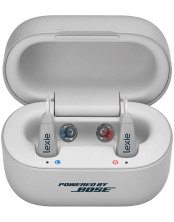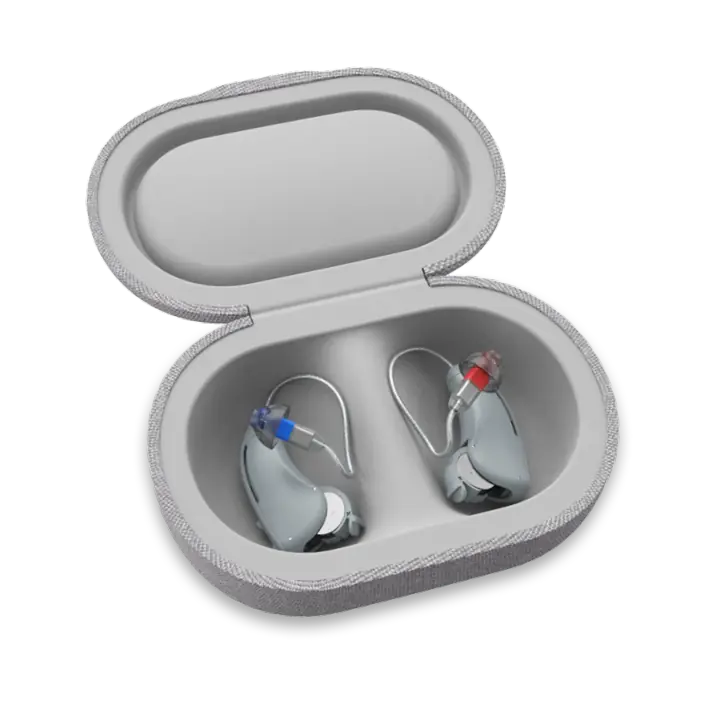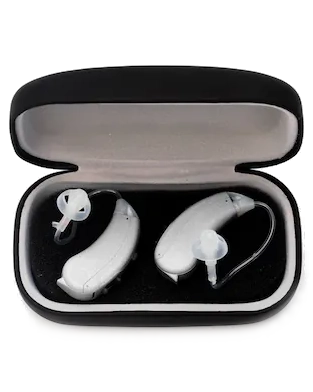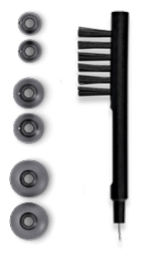What is Hearing Aid Directionality?
Published: June 25, 2021
Updated: July 22, 2022
The way we hear is an amazing process and hearing aid directionality makes it possible for a hearing aid wearer to hear as normally as possible. When you hear normally you might not even be aware of how your brain applies directional hearing. The brain is known to automatically filter out excess background noise and allow you to focus on speech and important sounds in your environment. Unfortunately, one of the biggest challenges many hard-of-hearing individuals face daily is being able to follow speech with competing background noise.
Before you select a hearing aid you may be bombarded by an influx of information on the various features a hearing aid has to offer. One such feature is the directionality of the hearing aid’s microphone. This is also a hearing aid feature that separates a hearing aid from a basic amplifier. The directionality of your device plays an important role in how successfully you will be able to distinguish speech from background noise. In this article, we’ll explore different features of hearing aid microphones and how each one will benefit your listening experience differently.
Omni-Directional Microphone
An omnidirectional hearing aid picks up sounds coming from all directions. These microphones pick up sound regardless of how important it is. An omnidirectional microphone is inexpensive and useful in environments that do not have high volumes of background noise. However, it is best suited for individuals who find themselves at home most of the time. Omni-directional microphones will not benefit you when you go to busy restaurants/ cafés, the mall, parties, or other social gatherings. These complex listening situations will be overwhelming for you as a hearing aid user and may only make listening even more challenging, tiring, and frustrating.
If your main complaint is that you struggle to hear speech in noise, a hearing aid with a directional microphone will be essential for you if you would like to hear better in those noisy listening situations.
Directional Microphone
One way to overcome poor audibility of speech in a noisy space is called directionality. Directional microphones focus on amplifying sounds coming from in front of you, more than sounds behind or next to you. The main goal of this hearing aid feature is to increase the signal-to-noise ratio in your social settings so that you experience clearer and better speech intelligibility whilst you’re socializing in noisy environments. Most importantly a directional microphone will enable you to focus better on your conversation partner and reduce the loudness of the competing voices around you.
The directional microphone system usually consists of two or more microphones that are separated by distance on the hearing aid. There’s generally a difference in the arrival time of the sound and speech to these microphones and the difference determines how your hearing aid will respond to the sound it has picked up.
Adaptive Directional Microphone
Adaptive directional microphone technology is one of the latest advances in hearing aid technology as it allows the microphone to automatically and dynamically adapt and change noise filters and its amplification as you move around between different listening situations. With adaptive directional microphones, your hearing aid will amplify all environmental sounds equally until you enter an environment where speech is present. This technology allows your hearing aid to pick up speech signals regardless of the direction it is coming from. In other words, an adaptive directional microphone can recognize speech signals from a single direction, but can automatically change the direction it is focusing on based on the speech and sound signals in the environment. All whilst increasing the signal-to-noise ratio.
Let’s give a real-world example of how the adaptive microphone works. Imagine sitting with a friend, or significant other, in a café or restaurant. The adaptive directional microphone technology will zoom in on your conversation partner’s voice in front of you. However, when your waiter comes to take your order the hearing aid will pick up a new speech signal (the waiter’s voice) and expand your listening area to hear the waiter too. By broadening the listening area you wouldn’t need to turn your head for your hearing aids to recognize the speech signal.
A common complaint many hard-of-hearing individuals have is the ability to follow conversations in a car. There’s noise originating from the road, inside the car, and maybe even the radio. When we drive in the car, the speech signal may not always come from the front, and you as a driver cannot face your conversational partners at all times. The adaptive directional microphone can focus on the target speaker, whether the signal is coming from the front, back, or next to you, whilst decreasing noise from around you. Similar to the directional microphone, the adaptive directional microphone aims to improve your overall speech intelligibility while reducing any focus or amplification of excessive background noise.
Why is directionality important?
Directionality is an important hearing aid feature that plays a valuable role in overcoming your hearing difficulties in loud background noise. Having a directional microphone can be a gift to you as a hearing aid user as it makes it much easier for you to discern the voices of your communication partners in a loud and noisy environment. Directionality matters, especially for individuals who place a lot of value in actively participating in conversations, thus hearing and understanding speech in quiet or noisy situations.
Everyday activities we often take for granted can become difficult when we lose our ability to hear in noisy environments. Imagine trying to hear your family and friends talk to you in a busy restaurant or crowded bar, or hearing public announcements at the airport, on the subway, railway station, or in a supermarket. Directional hearing aids do so much more than just improve speech intelligibility in noisy situations, it also makes it easier for you to pay attention and focus on your conversational partner by removing any distracting ambient sounds.
Lexie hearing aids offer the option of adjustable directional and adaptive microphone technology. If you are intrigued and curious to find out whether or not a directional microphone is best suited for your listening needs do not hesitate and contact a Lexie hearing expert today.






